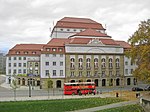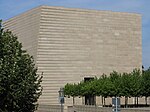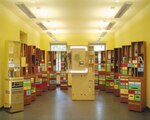Sächsische Staatskanzlei
Buildings and structures in DresdenGovernment of Saxony

The Sächsische Staatskanzlei (Saxon State Chancellery or Saxon State Chamber) is the office of the Minister-President of Saxony. It is in Dresden on the northern Elbe river banks and was established in 1995. The Staatskanzlei is managed by the State Minister and Head of the Staatskanzlei. The Free State of Saxony also established a Staatskanzlei between 1918 and 1945. The building was used by the Rat des Bezirkes (Board of the Bezirk) of the Bezirk Dresden after the German Democratic Republic had established the Bezirk subdivisions in 1952.
Excerpt from the Wikipedia article Sächsische Staatskanzlei (License: CC BY-SA 3.0, Authors, Images).Sächsische Staatskanzlei
Wigardstraße, Dresden Innere Neustadt (Neustadt)
Geographical coordinates (GPS) Address Website External links Nearby Places Show on map
Geographical coordinates (GPS)
| Latitude | Longitude |
|---|---|
| N 51.057 ° | E 13.749 ° |
Address
Sächsische Staatskanzlei / Sächsisches Staatsministerium für Regionalentwicklung
Wigardstraße
01097 Dresden, Innere Neustadt (Neustadt)
Saxony, Germany
Open on Google Maps











